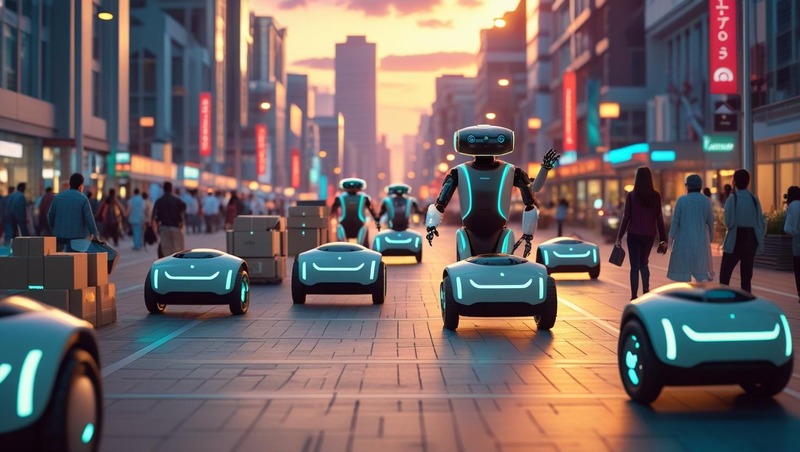Artificial Intelligence (AI) is rapidly transforming the landscape of the delivery robots market, turning once-basic autonomous machines into intelligent, efficient, and adaptable service solutions. From navigating complex urban environments to making real-time decisions based on dynamic variables, AI is at the heart of this revolution. As e-commerce booms, labor costs rise, and consumer expectations for speed and convenience grow, delivery robots enhanced with AI are emerging as the future of last-mile delivery.
One of the most significant ways AI is revolutionizing delivery robots is through advanced navigation and obstacle avoidance. Traditional autonomous systems often relied on fixed paths or simple sensors, limiting their ability to operate in unpredictable environments. AI-powered delivery robots, on the other hand, leverage machine learning, computer vision, and real-time data processing to perceive and interpret their surroundings. They can recognize traffic patterns, pedestrians, road signs, and obstacles, allowing them to make on-the-fly decisions and reroute in response to sudden changes — such as construction zones or temporary barriers — with a high level of accuracy.

Another key area where AI is making a profound impact is route optimization and operational efficiency. Using predictive analytics and real-time traffic data, AI algorithms can determine the most efficient delivery routes, taking into account weather, congestion, delivery priority, and energy consumption. This capability enables faster delivery times, better battery utilization, and more deliveries per charge cycle, significantly improving the robot’s return on investment for businesses. Over time, the AI system learns from past deliveries and continuously fine-tunes its route planning for even greater efficiency.
AI is also driving contextual understanding and human interaction in delivery robots. As these machines are increasingly deployed in public spaces such as sidewalks, office complexes, campuses, and residential neighborhoods, their ability to interact safely and effectively with humans becomes essential. AI allows delivery robots to interpret gestures, voice commands, and body language, enabling smoother interactions with recipients and bystanders. Some AI-enabled robots are even programmed with natural language processing (NLP) to answer basic questions or respond to instructions, enhancing user experience and trust.
Security and package integrity are also being enhanced by AI. Intelligent cameras, biometric verification, and anomaly detection algorithms help ensure that deliveries are made to the correct recipient and reduce the risk of theft or tampering. If a robot detects suspicious behavior or unauthorized access attempts, it can trigger alerts or even alter its delivery route to avoid compromised areas. This layer of AI-based security is particularly valuable for high-value items and confidential shipments.
In terms of fleet management and scalability, AI enables centralized control systems to coordinate and monitor large fleets of delivery robots simultaneously. These systems can track each robot’s location, performance, and maintenance needs in real time, allowing companies to deploy resources more effectively. AI models also forecast demand based on historical patterns, weather conditions, and seasonal trends, ensuring that delivery fleets are scaled appropriately and remain responsive to changing logistics needs.
Furthermore, AI is facilitating seamless integration with smart cities and IoT ecosystems. Delivery robots equipped with AI can interact with connected infrastructure, such as smart traffic lights, elevators, security systems, and access-controlled doors. This interoperability enables delivery robots to navigate buildings, cross intersections safely, and deliver packages directly to secure lockers or doorstep drop zones without human intervention.
As AI technologies continue to evolve, we are witnessing the emergence of fully autonomous delivery ecosystems, where robots can not only perform deliveries but also handle tasks like autonomous recharging, environmental monitoring, and collaborative swarm delivery for high-volume areas. In the future, AI will likely empower delivery robots to handle more complex and dynamic tasks, including multi-stop deliveries, real-time problem-solving, and autonomous coordination with drones and other autonomous vehicles.
Explore In-Depth Semiconductor & Electronics Market Research – https://www.marketsandmarkets.com/semiconductorand-electonics-market-research-87.html
Frequently Asked Questions (FAQs) on the Delivery Robots Market
What are delivery robots?
Delivery robots are autonomous or semi-autonomous machines designed to transport goods, packages, or food items from one location to another using AI, sensors, and navigation systems.
How do delivery robots work?
Delivery robots use a combination of GPS, LIDAR, cameras, and artificial intelligence to navigate sidewalks, streets, and buildings. They detect obstacles, follow routes, and interact with users during delivery.
What are the key applications of delivery robots?
They are used in last-mile delivery for food, groceries, parcels, medicines, and retail products. Industries such as e-commerce, hospitality, healthcare, and logistics widely adopt them.
How is AI used in delivery robots?
AI helps delivery robots with route optimization, real-time obstacle detection, autonomous decision-making, object recognition, and efficient customer interaction through natural language processing.
What are the main benefits of using delivery robots?
They reduce delivery time and cost, enhance efficiency, operate 24/7, support contactless delivery, and minimize human error in logistics operations.
Which industries are driving the demand for delivery robots?
E-commerce, food delivery, healthcare, and retail are leading sectors adopting delivery robots to streamline last-mile delivery and enhance customer experience.
See The Latest Semiconductor Reports:
AI Data Center Market by Offering (Compute Server (GPU-Based, FPGA-Based, ASIC-based), Storage, Cooling, Power, DCIM), Data Center Type (Hyperscale, Colocation), Application (GenAI, Machine Learning, NLP, Computer Vision) – Global Forecast to 2030
Embodied AI Market by Product Type [Robots (Humanoid Robots, Mobile Robots, Industrial Robots, Service Robots, Cobots), Exoskeletons, Autonomous Systems, Smart Appliances], Level of Embodiment (Level 1, Level 2, Level 3) – Global Forecast to 2030